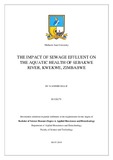Please use this identifier to cite or link to this item:
https://cris.library.msu.ac.zw//handle/11408/3729| Title: | The impact of sewage effluent on the aquatic health of Sebakwe river, Kwekwe, Zimbabwe | Authors: | Manhire, Billie | Keywords: | Sewage treatment plants Zimbabwe |
Issue Date: | 2019 | Publisher: | Midlands State University | Abstract: | Many of the sewage treatment plants in Zimbabwe have not been upgraded to accommodate the population increases that the cities have undergone. This has resulted in the release of raw or partially treated sewage into rivers, which negatively impacts the ecological health of these ecosystems. The aim of this study was to determine the impact of sewage effluent on the aquatic health of Sebakwe River, Kwekwe. Monthly surveys of macroinvertebrates and water variables were carried out from September 2018 to January 2019, to cover the wet and dry seasons. Three upstream and three downstream sampling sites were used to evaluate the effects of sewage effluent being discharged into Sebakwe River by the city’s sewage treatment plant. Macroinvertebrate sampling was done according to South African Scoring System (SASS) 5 index protocol. In situ water analyses of electrical conductivity, DO, pH and temperature were carried out using metres. The macroinvertebrates present in the water were identified up to family level. The results showed no significant differences (p>0.05) in seasonal and spatial variation of the physicochemical variables. Species richness varied among the sites. The highest species richness was recorded at the first upstream site while the lowest species richness was recorded at the sampling site immediately after discharge of sewage effluent. The upstream and downstream sites had average ASPT scores of 7.64 and 4.23 respectively, indicating that the downstream sites were unhealthy. The first upstream site had pollution-sensitive taxa from the family of Trichoptera indicating good river health. Pollution sensitive taxa such as Zygoptera were common upstream while the downstream sites were dominated by pollution insensitive taxa such as Oligochaetae, Hirudinea and Diptera. The site immediately after point source pollution had an abundance of water hyacinth indicating nutrient pollution. The health downstream of Sebakwe River is very low since pollution-tolerant taxa showed low species richness but high evenness. The measured environmental variables were not important in describing the macroinvertebrate diversity. Future studies on rivers should include measurements on nutrient variables as these have a great impact on river health. SASS 5 index should be formally adopted and used to regularly assess the health of all rivers in the country to help keep organic pollution levels low. | URI: | http://hdl.handle.net/11408/3729 |
| Appears in Collections: | Bachelor Of Science In Applied Biosciences And Biotechnology Honours Degree |
Files in This Item:
| File | Description | Size | Format | |
|---|---|---|---|---|
| BILLIE MANHIRE - DISSERTATION.pdf | Full Text | 944.88 kB | Adobe PDF |  View/Open |
Page view(s)
190
checked on Feb 26, 2025
Download(s)
256
checked on Feb 26, 2025
Google ScholarTM
Check
Items in MSUIR are protected by copyright, with all rights reserved, unless otherwise indicated.


